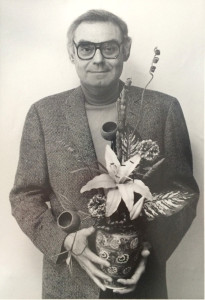
Dr. Alvin J. Reines was Professor of Philosophy and Theology at the Hebrew Union College-Jewish Institute of Religion, the rabbinical seminary of Reform Judaism in Cincinnati, Ohio. Born in Paterson, New Jersey in 1926, he graduated from Yeshiva College, attended NYU Law School, and received rabbinic ordination from the Hebrew Union College in 1952. He received a Doctorate in Philosophy from Harvard University in 1958 and joined the faculty of the Hebrew Union College that same year. At Harvard, Dr. Reines was a student of Professor Harry A. Wolfson, and specialized in medieval philosophy, particularly the great medieval Jewish philosophers, Maimonides and Abrabanel. His work on these philosophers, Maimonides and Abrabanel on Prophecy, was published by the Hebrew Union College Press in 1970. He is considered to be the person who broke the ancient code of Maimonides.
Dr. Reines conceived the concept of Polydoxy and spent his life describing and demonstrating how a liberal religious community, which embraces the freedom of each individual, could be implemented. He stated that “during the years of education at both the Hebrew Union College and Harvard, it became clear to me that Reform Judaism–although ostensibly taught and practiced–possessed no definition of what, in fact, it was. Upon analysis, I came to the realization that Reform Judaism was a polydoxy: a religion that is not based upon an infallible revelation. A polydoxy has for its essence a Freedom Covenant; namely, a covenant in which every person affirms the autonomy of all other persons in return for their affirmation of his or her self-authority. (Accordingly, for example, every person has the moral right to determine what the term ‘god’ means for him or her.)
Dr. Reines’ seminal book on Liberal Religion is Polydoxy: Explorations in a Philosophy of Liberal Religion (Buffalo: Prometheus Books, 1987).
“(While in graduate school,) I became convinced that a fundamentally new form of religion was in the process of evolving out of the authoritarian orthodox and fundamentalist religions traditional in the Western world.
There have been major indications that a new religious form is emerging. One is the great number of persons who have disaffiliated themselves from their native orthodox and fundamentalist religions in favor of pursuing independent religious choices. Another is the many persons who, despite affiliation with orthodox and fundamentalist religions, reject their authority, and make personal decisions in religious matters. Still another is the existence of various religious structures called “Liberal.” Notably these include: Liberal Protestantism, Liberal Catholicism, Liberal Judaism, and Liberal Unitarian Universalism. While individuals who reject the authority of the traditional orthodox and fundamentalist religions and the existence of “Liberal” religions point to a new religious form, they themselves provide no clear idea of precisely what the new religion is. Even the “Liberal” religions which possess a formal institutional structure fail to present . . . a fundamental principle or coherent foundation doctrine.
“Liberal religions present a chaotic appearance because they are at a halfway point of development from the orthodox and fundamentalist systems from which they emerged; they therefore exhibit a mélange of bits from the past, pieces from the present, and potentialities for the future. They have not yet reached the new religious form toward which they are tending.
I have given the name “polydoxy” to define this new form of religion.”
Preface: Polydoxy: Explorations in a Philosophy of Liberal Religion, 1987
